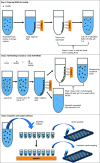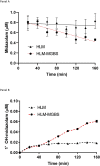Human Liver Microsomes Immobilized on Magnetizable Beads: A Novel Approach to Study In Vitro Drug Metabolism
- PMID: 32474441
- PMCID: PMC7370995
- DOI: 10.1124/dmd.120.090696
Human Liver Microsomes Immobilized on Magnetizable Beads: A Novel Approach to Study In Vitro Drug Metabolism
Abstract
Human liver microsomes (HLM) are a commonly used tool to study drug metabolism in vitro. Typical experiments conducted using suspensions of HLM can be challenging to separate from the incubation solution without lengthy ultracentrifugation steps. Magnetizable beads coated with silica (MGBS) were found to bind strongly to HLM, which could then be isolated and purified using a magnet. Binding of HLM to the MGBS (HLM-MGBS) was demonstrated to be mediated by strong interactions between microsomal phospholipids and MGBS, as artificially prepared phosphatidylcholine (PC) liposomes could be more efficiently captured by the MGBS. HLM-MGBS complexes retained functional cytochrome P450 and uridine-diphosphate-glucuronosyltransferase (UGT) activity as indicated by CYP2C8-mediated amodiaquine de-ethylation, CYP3A4-mediated midazolam 1'hydroxylation, UGT1A1-mediated glucuronidation of estradiol, UGT1A9-mediated glucuronidation of propofol, and UGT2B7-mediated glucuronidation of zidovudine. When comparing suspension HLM alone with HLM-MGBS complexes containing equivalent amounts of HLM, the intrinsic clearance (CLint) of CYP450 substrates was comparable; however, CLint of UGT1A1, UGT1A9, and UGT2B7 was increased in the HLM-MGBS system between 1.5- and 6-fold. HLM-MGBS used in an incubation could also be readily replaced with fresh HLM-MGBS to maintain the presence of active enzymes. Thus, HLM-MGBS demonstrate increased in vitro metabolic efficiency and manipulability, providing a new platform for determination of accurate metabolic parameters. SIGNIFICANCE STATEMENT: The following work describes the strong binding of HLM to magnetizable beads. In addition, the preservation of enzyme activity on the bound HLM provides a novel means to conduct preclinical metabolism studies.
Copyright © 2020 by The American Society for Pharmacology and Experimental Therapeutics.
Figures









Similar articles
-
In Vitro Characterization of Ertugliflozin Metabolism by UDP-Glucuronosyltransferase and Cytochrome P450 Enzymes.Drug Metab Dispos. 2020 Dec;48(12):1350-1363. doi: 10.1124/dmd.120.000171. Epub 2020 Oct 5. Drug Metab Dispos. 2020. PMID: 33020067
-
Glucuronidation of edaravone by human liver and kidney microsomes: biphasic kinetics and identification of UGT1A9 as the major UDP-glucuronosyltransferase isoform.Drug Metab Dispos. 2012 Apr;40(4):734-41. doi: 10.1124/dmd.111.043356. Epub 2012 Jan 11. Drug Metab Dispos. 2012. PMID: 22238289
-
Direct comparison of UDP-glucuronosyltransferase and cytochrome P450 activities in human liver microsomes, plated and suspended primary human hepatocytes from five liver donors.Eur J Pharm Sci. 2017 Nov 15;109:96-110. doi: 10.1016/j.ejps.2017.07.032. Epub 2017 Aug 1. Eur J Pharm Sci. 2017. PMID: 28778465
-
Scaling factors for the in vitro-in vivo extrapolation (IV-IVE) of renal drug and xenobiotic glucuronidation clearance.Br J Clin Pharmacol. 2016 Jun;81(6):1153-64. doi: 10.1111/bcp.12889. Epub 2016 Mar 14. Br J Clin Pharmacol. 2016. PMID: 26808419 Free PMC article.
-
System-dependent outcomes during the evaluation of drug candidates as inhibitors of cytochrome P450 (CYP) and uridine diphosphate glucuronosyltransferase (UGT) enzymes: human hepatocytes versus liver microsomes versus recombinant enzymes.Drug Metab Pharmacokinet. 2010;25(1):16-27. doi: 10.2133/dmpk.25.16. Drug Metab Pharmacokinet. 2010. PMID: 20208386 Review.
Cited by
-
Drugs Form Ternary Complexes with Human Liver Fatty Acid Binding Protein 1 (FABP1) and FABP1 Binding Alters Drug Metabolism.Mol Pharmacol. 2024 May 17;105(6):395-410. doi: 10.1124/molpharm.124.000878. Mol Pharmacol. 2024. PMID: 38580446 Free PMC article.
-
Integrate thermostabilized fusion protein apocytochrome b 562 RIL and N-glycosylation mutations: A novel approach to heterologous expression of human UDP-glucuronosyltransferase (UGT) 2B7.Front Pharmacol. 2022 Aug 12;13:965038. doi: 10.3389/fphar.2022.965038. eCollection 2022. Front Pharmacol. 2022. PMID: 36034790 Free PMC article.
-
Drugs Form Ternary Complexes with Human Liver Fatty Acid Binding Protein (FABP1) and FABP1 Binding Alters Drug Metabolism.bioRxiv [Preprint]. 2024 Jan 19:2024.01.17.576032. doi: 10.1101/2024.01.17.576032. bioRxiv. 2024. Update in: Mol Pharmacol. 2024 May 17;105(6):395-410. doi: 10.1124/molpharm.124.000878. PMID: 38293009 Free PMC article. Updated. Preprint.
-
Nanobioelectrocatalysis Using Human Liver Microsomes and Cytochrome P450 Bactosomes: Pyrenyl-Nanocarbon Electrodes.ACS Appl Bio Mater. 2024 Apr 15;7(4):2197-2204. doi: 10.1021/acsabm.3c01170. Epub 2024 Mar 3. ACS Appl Bio Mater. 2024. PMID: 38431903 Free PMC article.
-
The In Vitro Pharmacokinetics of Medicinal Plants: A Review.Pharmaceuticals (Basel). 2025 Apr 9;18(4):551. doi: 10.3390/ph18040551. Pharmaceuticals (Basel). 2025. PMID: 40283986 Free PMC article. Review.
References
-
- Achour B, Al Feteisi H, Lanucara F, Rostami-Hodjegan A, Barber J. (2017) Global proteomic analysis of human liver microsomes: rapid characterization and quantification of hepatic drug-metabolizing enzymes. Drug Metab Dispos 45:666–675. - PubMed
-
- Berka K, Paloncýová M, Anzenbacher P, Otyepka M. (2013) Behavior of human cytochromes P450 on lipid membranes. J Phys Chem B 117:11556–11564. - PubMed
-
- Bradford MM. (1976) A rapid and sensitive method for the quantitation of microgram quantities of protein utilizing the principle of protein-dye binding. Anal Biochem 72:248–254. - PubMed
MeSH terms
Substances
LinkOut - more resources
Full Text Sources

